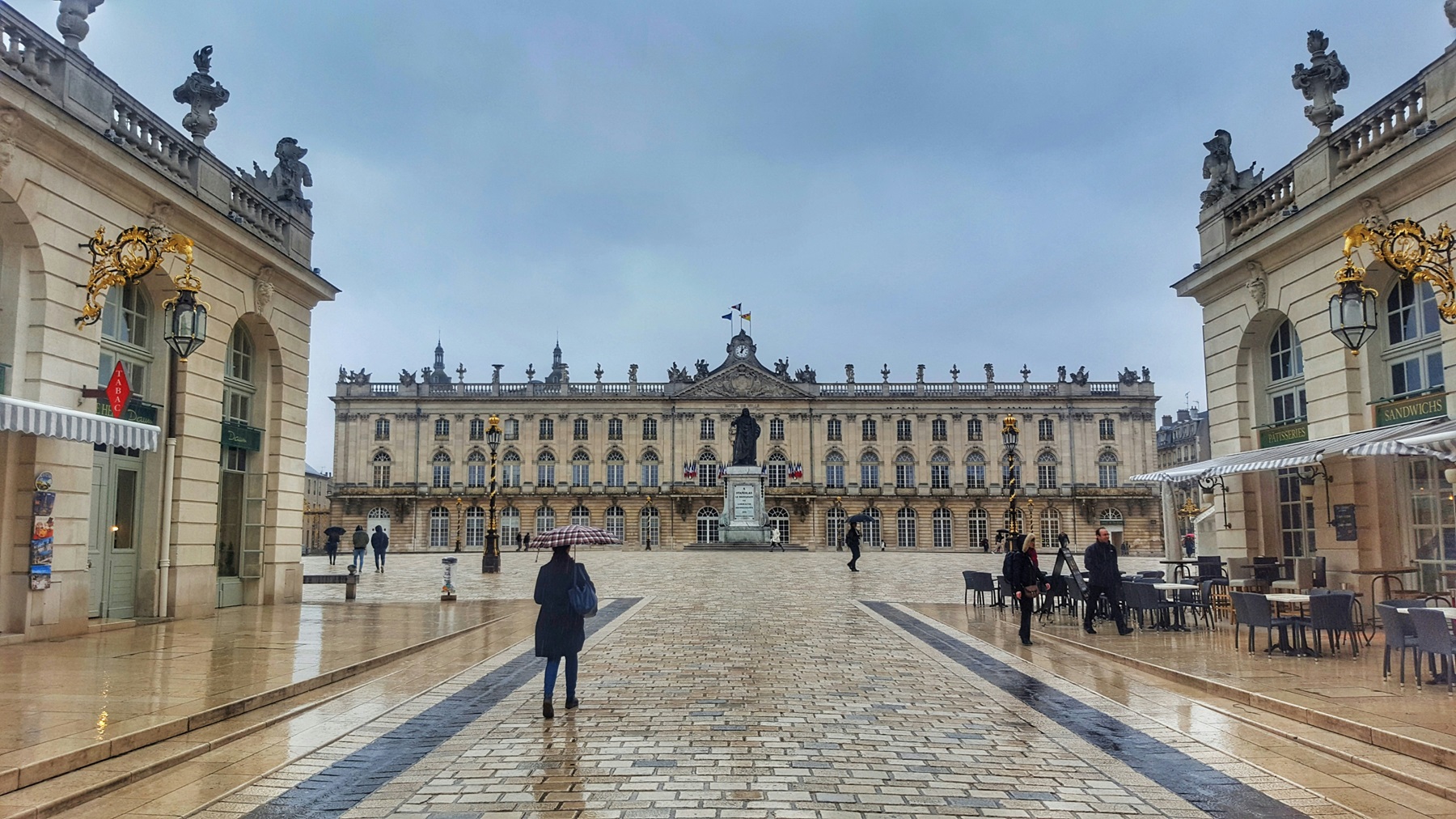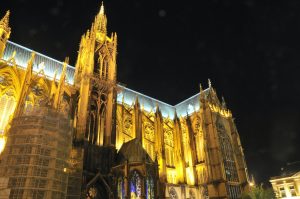Quick search
CTRL+K
Quick search
CTRL+K

Metz is a city in eastern France on the Moselle River close to the borders with Belgium, Germany and Luxembourg. Its history goes back several thousand years, and after the Roman Empire’s conquest of the Gallic area in 52 BC, the city became one of the largest in Gaul, with up to 40,000 inhabitants. In the 4th century, Metz became part of the Frankish Empire, and in the following centuries it was a city of residence. In 843, Metz became the capital of Lotharingia, and later it formed a part of the Teutonic Roman Empire.
Metz was a republic for centuries before becoming part of the Kingdom of France in 1552, which however was only formalized with the Peace of Westphalia in 1648. In 1871 Metz changed status once again becoming a part of the German Empire and Germanization was initiated before the city returned to France after the end of the First World War.
Today you can enjoy some wonderful walks in the center of Metz, and you can start at the Place d’Armes, the city’s central square. Here you can see the city’s town hall, which was built 1769-1771 in neoclassical style. Opposite the town hall is Metz’s cathedral, Cathédrale Saint-Étienne, which was built in the Gothic style from the 14th century and consecrated in 1562. The cathedral is known for its 41-metre-high nave, which is one of the tallest in France, and for the countless glass mosaics which adorn the church.
The mosaics cover a total of approximately 6,500 m2, and it is one of the largest surfaces of glass mosaics in the world. You can also see the rich religious treasures that have been collected over the past approximately 1,000 years. From the cathedral you can walk in the old streets and in pleasant squares such as Place Saint-Jacques and the promenades along the Moselle.
Here you can go to the island of Île du Petit-Saulcy, located in the Moselle. Here is the Place de la Comédie, where you can see the city’s opera house. The Opéra-Théâtre de Metz Métropole was built between 1732 and 1752, and it is still in operation as the oldest of its kind in France. At the end of the Place de la Comédie, you can visit the Temple Neuf church, built from 1901 and inaugurated in 1904 in the presence of Emperor Wilhelm II.
There were city walls until the end of the 1800s, when they were torn down. However, there are still preserved parts of the city’s former defenses such as the Porte des Allemands, a fortress-like city gate that was built in the 13th and 15th centuries. Of Metz’s 17 medieval city gates, only this one has been preserved. In the southern part of the center is the Église Saint-Pierre-aux-Nonnains, which is one of Europe’s oldest churches. The building dates to the 4th century Roman times, when it was part of a bathing facility. It became a church in the 6th century.
You can also take a walk in the so-called imperial quarter, Quartier Impérial, which was largely built between 1902 and 1914 during the region’s German era. The neighborhood was called Neue Stadt and was built south of the city center near Metz’s railway station. The neighborhood was to both modernize and germanize Metz.
You can see fine examples of the German district along Avenue Foch and in the streets towards the railway station, where you can explore a great variety of architecture. The railway station itself is also from this time, and it was the Berliner Jürgen Kröger who designed it in a Germanic style. The beautiful station building was built between 1905 and 1908 and replaced the former railway station which can still be seen on Place du Roi George.

Nancy is the capital of the Meurthe-et-Moselle department in eastern France. Historically, the city was the capital of the Duchy of Lorraine, which existed from 959 to 1766, when it was annexed by Louis XV’s France. Nancy’s history goes back a long time, and the city was known as the fortified Nanciacum from the middle of the 11th century. The town burned down in 1218 during the succession war in Champagne. Over the following centuries, the city was rebuilt, and as the capital of Lorraine, the importance of Nancy grew.

Saarbrücken is the capital of the state of Saarland, and the city’s name means the bridges over the river Saar. Saarbrücken dates back more than a thousand years, and for over 400 years the counts of Nassau-Saarbrücken ruled the city until 1793, when French revolutionary troops captured the city. In 1815, Saarbrücken became part of a Prussian province, and Saarland finally became part of Germany on January 1, 1957.

Luxembourg is the cozy capital of the country of the same name. At the strategically important site where Roman trade routes intersected, fortifications have been built ever since the city’s founding on the rocky promontories on the Alzette River.
Raised across the river are the compact city centers with atmospheric plazas, churches, museums and many places of magnificent views of the river valley to some of the city’s newer neighborhoods. This is where you will find, among others, the Luxembourg Grand Duke’s Palace, the city’s cathedral and several atmospheric plazas with Place d’Armes at the forefront.
 Metz, France[/caption]
Metz, France[/caption]
Overview of Metz
Metz is a city in eastern France on the Moselle River close to the borders with Belgium, Germany and Luxembourg. Its history goes back several thousand years, and after the Roman Empire’s conquest of the Gallic area in 52 BC, the city became one of the largest in Gaul, with up to 40,000 inhabitants. In the 4th century, Metz became part of the Frankish Empire, and in the following centuries it was a city of residence. In 843, Metz became the capital of Lotharingia, and later it formed a part of the Teutonic Roman Empire.
Metz was a republic for centuries before becoming part of the Kingdom of France in 1552, which however was only formalized with the Peace of Westphalia in 1648. In 1871 Metz changed status once again becoming a part of the German Empire and Germanization was initiated before the city returned to France after the end of the First World War.
Today you can enjoy some wonderful walks in the center of Metz, and you can start at the Place d’Armes, the city’s central square. Here you can see the city’s town hall, which was built 1769-1771 in neoclassical style. Opposite the town hall is Metz’s cathedral, Cathédrale Saint-Étienne, which was built in the Gothic style from the 14th century and consecrated in 1562. The cathedral is known for its 41-metre-high nave, which is one of the tallest in France, and for the countless glass mosaics which adorn the church.
About the Metz travel guide
Contents: Tours in the city + tours in the surrounding area
Published: Released soon
Author: Stig Albeck
Publisher: Vamados.com
Language: English
About the travel guide
The Metz travel guide gives you an overview of the sights and activities of the French city. Read about top sights and other sights, and get a tour guide with tour suggestions and detailed descriptions of all the city’s most important churches, monuments, mansions, museums, etc.
Metz is waiting for you, and at vamados.com you can also find cheap flights and great deals on hotels for your trip. You just select your travel dates and then you get flight and accommodation suggestions in and around the city.
Read more about Metz and France
France Travel Guide: https://vamados.com/france
City tourism: https://visitme-tz.fr
Main Page: https://www.vamados.com/
Buy the travel guide
Click the “Add to Cart” button to purchase the travel guide. After that you will come to the payment, where you enter the purchase and payment information. Upon payment of the travel guide, you will immediately receive a receipt with a link to download your purchase. You can download the travel guide immediately or use the download link in the email later.
Use the travel guide
When you buy the travel guide to Metz you get the book online so you can have it on your phone, tablet or computer – and of course you can choose to print it. Use the maps and tour suggestions and you will have a good and content-rich journey.

Similar to Metz Travel Guide
